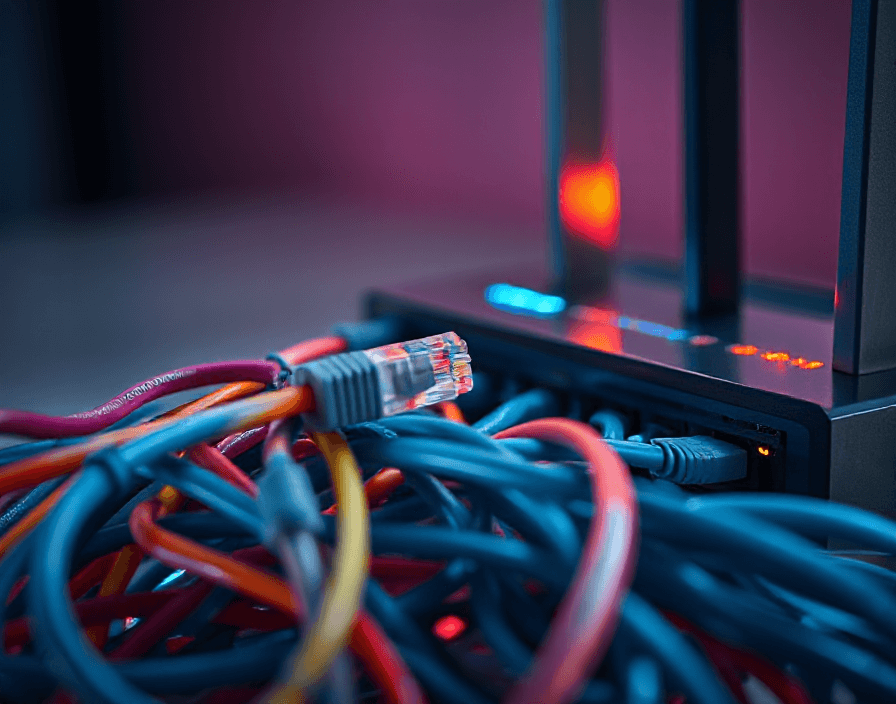How Physical and Data-Link Layers Enable Ethernet and Wi-Fi
Learn how the Physical and Data-Link Layers power Ethernet and Wi-Fi communication. Understand frame encapsulation, MAC addressing, and how these layers ensure reliable, secure LAN connectivity.

The Physical and Data Link Layers are essential to Ethernet and Wi-Fi, providing the framework for data transmission. The Physical Layer translates binary data into signals for transmission over cables or wireless frequencies. Meanwhile, the Data-Link Layer guarantees data integrity by encapsulating information into frames, managing error detection, and avoiding collisions through protocols like CSMA/CA in Wi-Fi. These layers enable efficient and reliable communication across networks. You’ll discover more about their roles and functions ahead.
Understanding the Physical Layer: The Foundation of Connectivity
Understanding the Physical Layer is fundamental because it underpins all network connectivity. At this layer, data manifests as electrical pulses, light signals, or radio frequencies.
You’ll find that the Physical Layer encompasses essential hardware components, including cables, connectors, antennas, and Network Interface Cards (NICs). It translates binary data into signals suitable for transmission across various media.
For Ethernet, standards like IEEE 802.3 dictate electrical signal characteristics, while IEEE 802.11 governs radio signal transmission for Wi-Fi. This layer guarantees interoperability among devices, defining how data travels through copper and fiber-optic cables or wireless channels.
Mastering the Physical Layer enables efficient troubleshooting and optimization, critical for reliable communication in both wired and wireless networks.
The Role of the Data-Link Layer in Reliable Communication
While the Physical Layer lays the groundwork for data transmission, the Data-Link Layer plays an essential role in guaranteeing reliable communication between devices. It encapsulates data into frames and manages error detection and flow control, greatly enhancing transmission integrity.
Key functions include:
- Frame Synchronization: Guarantees that data frames are correctly aligned for processing.
- Error Detection: Utilizes CRC to identify and correct errors in transmitted data.
- Media Access Control: Determines how multiple devices share the communication medium without collisions.
- Addressing: Embeds MAC addresses to identify devices, facilitating accurate data delivery uniquely.
Ethernet: Standards and Frame Structure
Ethernet standards define the framework for data encapsulation and transmission within local area networks (LANs). Compliant with IEEE 802.3, these standards guarantee interoperability and define the physical and data link layers of Ethernet communication.
Each Ethernet frame consists of a preamble, destination and source MAC addresses, a type/length field, the payload, and a Frame Check Sequence (FCS) for error detection. The MAC addresses uniquely identify devices, while the payload carries the encapsulated data. This structure allows for efficient data transfer and collision management, especially in switched environments.
Full-duplex operation enhances performance by enabling simultaneous send and receive capabilities, drastically improving throughput and reliability in network communications. Understanding these standards and frame structures is vital for effective network design and troubleshooting.
Wi-Fi: Managing Wireless Communications
As you explore wireless communications, it’s essential to understand how Wi-Fi operates within the framework established by the Physical and Data Link Layers.
Wi-Fi effectively manages wireless communications through a combination of protocols and mechanisms that guarantee reliable data transfer in a shared medium.
Key aspects include:
- Carrier Sense Multiple Access with Collision Avoidance (CSMA/CA): Prevents data collisions by enabling devices to check medium availability before transmission.
- Frame Structure: Incorporates headers for addressing, authentication, and retransmission, enhancing data integrity.
- Frequency Bands: Utilizes 2.4 GHz and 5 GHz bands to optimize performance and reduce interference.
- Access Points: Function as a bridge between wireless clients and the wired network, facilitating seamless communication.
These elements work together to maintain efficient, secure wireless connections.
Error Handling and Security Mechanisms in Networking
Effective error handling and robust security mechanisms are crucial components of networking that guarantee data integrity and protection against unauthorized access. In the context of Ethernet and Wi-Fi, these mechanisms work together to guarantee reliable communication.
| Mechanism | Description |
|---|---|
| CRC Error Detection | Verifies data integrity by checking for errors. |
| Retransmission Requests | Requests resend of corrupted frames. |
| Port Security | Controls which MAC addresses can access ports. |
| WPA2/WPA3 Encryption | Secures data during transmission over Wi-Fi. |
| MAC Address Filtering | Blocks unauthorized devices from accessing the network. |
Through these methods, you can maintain robust network performance while safeguarding sensitive information from potential threats. Understanding these processes is crucial for effective network management and security.
Frequently Asked Questions
What Types of Cables Are Used in Ethernet Connections?
You’ll typically use twisted pair cables like Cat5e or Cat6 for Ethernet connections. Fiber optic cables are also standard, especially for long distances, offering higher speeds and reduced interference compared to traditional copper cables.
How Do Signal Interferences Affect Data Transmission?
Signal interferences disrupt data transmission by introducing noise, causing errors, and leading to packet loss. You’ll need to implement error-detection and correction mechanisms to ensure reliable communication amid these disturbances in your network environment.
What Is the Purpose of a MAC Address?
A MAC address uniquely identifies your network device on a local network. It guarantees accurate data delivery by allowing switches to forward frames to their intended destinations, preventing collisions, and maintaining effective communication between devices.
How Is Bandwidth Allocated in Wi-Fi Networks?
In Wi-Fi networks, bandwidth is allocated using techniques such as Carrier Sense Multiple Access with Collision Avoidance (CSMA/CA), which allow devices to sense channel availability before transmitting, minimize interference, and ensure fair access among multiple users.
What Factors Influence the Choice of Network Interface Cards?
When choosing network interface cards, consider compatibility with your system, desired speed, connection type, and supported protocols. You should also evaluate power consumption, form factor, and any specific features required for your network’s performance and security needs.



